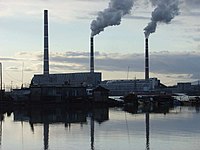
Photo from wikipedia
Abstract Many studies and standards in the building sector have often focused on the mitigation of operational carbon with little consideration of the embodied carbon from buildings. Although there exist… Click to show full abstract
Abstract Many studies and standards in the building sector have often focused on the mitigation of operational carbon with little consideration of the embodied carbon from buildings. Although there exist some studies on embodied carbon, they are analyzed based on the project level or case studies, and few studies explore the embodied carbon dioxide in the building sector. To achieve the peaking of China’s carbon emission by 2030, a process-based approach and a disaggregated input-output model in this study were adopted to estimate the annual embodied carbon dioxide from the China’s building sector, respectively. The results of embodied carbon dioxide emissions were 1421.70 Mt and 1599.62 Mt in the building sector in 2015, respectively. In terms of building types, the embodied carbon dioxide in the residential building sector is about 1.5–2.2 times that of the non-residential building sector. In addition, it is indicated that, unlike the small magnitude of embodied carbon compared with operational carbon in life cycle of buildings, the annual embodied carbon dioxide accounts for roughly one-half in the total carbon dioxide emissions in the building sector in 2015. The study provides an understanding of the embodied carbon and its composition of different industrial materials that would be useful for China to develop its future CO2 emission control plan.
Journal Title: Journal of Cleaner Production
Year Published: 2020
Link to full text (if available)
Share on Social Media: Sign Up to like & get
recommendations!